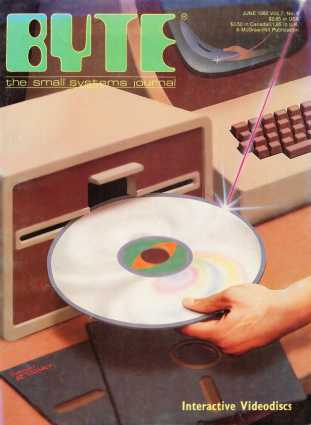
Learn how to develop interactive videodisc programs.
[author : Rod Daynes]
Wicat Systems presents a systematic approach to the design, development. and production of an interactive videodisc system.
You can use your personal computer to control a Pioneer VP-1000 laser-optical videodisc player through its remote-control circuitry.
[author : Steve Ciarcia]
Educators are discovering ways to use videodiscs as an aid to learning.
[author : Isaac I. Bejar]
Computer and videodisc technologies are combined to provide instruction in lifesaving techniques.
[author : David Hon]
We may soon be measuring mass storage in gigabytes.
[author : Dick Moberg and Ira M. Laefsky]
A survey of what's in the proposed ANSI standard and why it's there.
[author : Thomas E. Kurtz]
Character codes turn computer data into messages that people can understand.
[author : Steve Leibson]
You can build this interface for less than $25 and plug it into the ROM cartridge slot.
[author : William Barden Jr.]
The critic reviews some new computer terminals, word-processing software, compilers, and M-drive.
[author : Jerry Pournelle]
The interaction between the computer and the person using it is the most important and the most often neglected aspect of commercial software.
[author : Chris Crawford]
Using translation programs to move CP/M-80 programs to CP/M and MS-DOS.
[author : Roger Taylor and Phil Lemmons]
Low-cost telecommunication capability for the Apple II.
[author : Tom Gabriele]
Repair service options to consider before you buy a computer and preventive maintenance steps to perform once you've made the purchase.
[author : Lewis A , Whitaker]
Simulate aircraft instrument navigation using simple trigonometry.
[author : Richard Campbell]
[author : Silas Pike]
[author : Stan Wszola]
[author : Jeff Bonar and Steve Levitan]
[author : Hartley G. Lesser]
[author : Mark Dahmke]
[author : Gregory MacNicol]
[author : Mahlon G. Kelly]
[author : Robert Moskowitz]
Imagine carrying around the entire Encyclopaedia Britannica in your shirt pocket with room left over for every issue ever published of The New York Times and then some. Videodiscs and optical data storage technology have the potential to make this a reality. They also promise to provide a medium for an effective delivery of information hitherto impossible. Several articles this month illustrate the possibilities. Dick Moberg and Ira M. Laefsky describe one use for videodiscs in "Videodiscs and Optical Data Storage." Rod Daynes presents a primer on the video aspects of videodisc production in "The Videodisc Interfacing Primer." In "Videodiscs in Education" Isaac I. Bejar discusses ways in which videodisc technology might affect teaching methods. David Hon describes teaching lifesaving techniques with the aid of videodiscs and computers in "Interactive Training in Cardiopulmonary Resuscitation." And Steve Ciarcia's project is how to "Build an Interactive-Videodisc Controller." Thomas E. Kurtz, co-author of the original Dartmouth BASIC, surveys what's in the proposed ANSI standard and why it's there. Roger Taylor and Phil Lemmons explain what's really involved in adapting 8-bit software to a 16-bit environment in "Upward Migration, Part 1: Translators." Steve Leibson's "The Input/Output Primer" continues with "Part 5: Character Codes." Of course, we have Jerry Pournelle, William Barden Jr., and all our other regular features.
